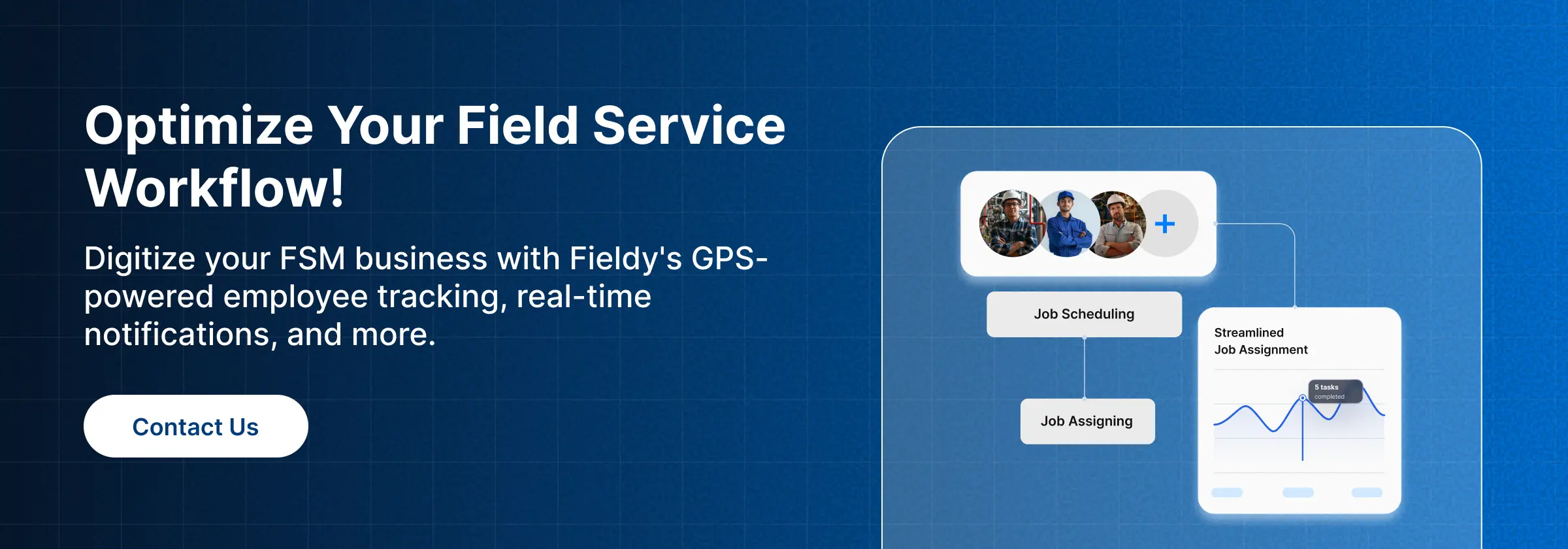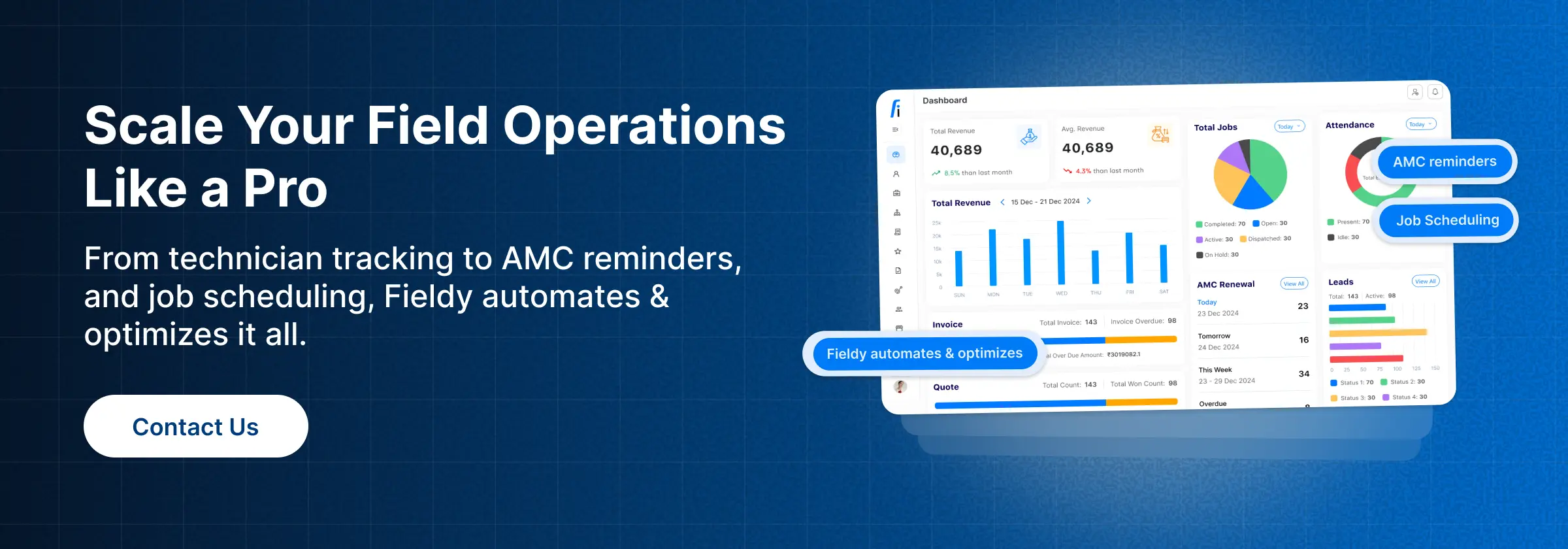👋 Introduction
Service managers and technicians no longer use sticky notes or paper-based forms to organize work in today’s service environments. They now rely on checklist field service software, where tools are integrated to improve the accuracy of information, meet compliance requirements, and boost team productivity. Digital checklists further streamline the entire process.
These checklists are no longer simple task lists. Instead, they are automated and integrated with other systems in the workflow. This cuts down on delays and removes the need for manual reporting. For instance, service managers can now get automatically generated compliance reports; this used to take managers hours to complete.
In this article, I will cover the new types of checklists for field service in 2025, the benefits and limitations of using these checklists, and how to implement them based on the best guidelines. We will also explore advanced checklists like the ones offered by Fieldy that not only reduce the complexity of checklist management but also help service teams stay compliant and consistent.
🗂️ 5 Key Types of Field Service Checklists
📅 1. Daily Operations Checklists
Plan checklists are crucial for field service departments. They help field technicians coordinate on routine services, make sure safety and quality guidelines are followed, and check important Field service metrics & KPIs like:
- First-Time Fix Rate (FTFR) – the percentage of jobs done successfully on the first visit without needing a follow-up visit.
- Average Response Time – how quickly service requests are serviced.
- Customer Satisfaction Scores – derived from feedback received after service.
The reason this is important: Consistent daily processes help to minimize mistakes and increase customer confidence. According to studies, field service organizations with the best performance have a median FTFR of approximately 70%, in contrast with 55% for those with inferior results.
Organizations that integrate daily checklists into their scheduling and dispatch procedures also notice clear enhancements in technician responsibility and fewer overlaps in job assignments.
Case Study: Within six months, a regional telecom firm that became an advocate for daily checklists for their technician work saw a 20% decrease in repeat service calls.
👷 2. Technician Onboarding & Training Checklists
Field service companies often deal with high staff turnover and workforce shortages. Structured onboarding and training checklists provide a reliable way to ensure every new technician learns critical skills quickly, including:
- Safety and regulatory compliance protocols
- How to use mobile field service apps effectively
- Customer service guidelines for handling interactions professionally
Why this matters: A standardized onboarding process shortens training time dramatically, cutting what used to take weeks down to just a few days. It also ensures that every technician, whether new or experienced, delivers consistent service quality.
Industry insight: More than 80% of field service leaders report that technician skills need frequent updates because of rapidly changing technologies. Having an onboarding checklist makes it easier to update training requirements and roll them out consistently across teams.
🧰 3. Equipment & Inventory Checklists
No technician can complete a job without the right parts or tools. Equipment and inventory checklists are designed to prevent stockouts, reduce overstocking, and ensure tools are maintained properly. They typically include:
- Barcode or QR code scanning for real-time parts tracking
- Automatic threshold alerts to restock before shortages occur
- Scheduled equipment maintenance logs to prevent breakdowns
Why this matters: Equipment downtime is one of the most common causes of delayed service. Companies that digitize inventory tracking with checklist-driven systems often report 20–30% reductions in maintenance costs and up to 50% fewer cases of equipment-related downtime.
Example: A national HVAC provider implemented mobile inventory checklists synced to its warehouses and reported a 25% increase in technician productivity, as workers always had the right parts on hand.
💬 4. Customer Communication Checklists
Customer experience is as important as technical accuracy. Customer communication checklists help technicians follow structured scripts, capture client feedback, and conduct post-job surveys. These may include:
- Greeting and explaining the service process clearly
- Confirming service completion with the customer before leaving the site
- Collecting signatures and satisfaction ratings digitally
- Triggering follow-up surveys automatically
Why this matters: Studies consistently show that clear communication during and after service visits drives higher customer loyalty and repeat business. In fact, nearly 9 out of 10 business leaders agree that their field service teams directly contribute to revenue growth by driving upsells and improving customer relationships.
Example: A solar installation company that introduced structured communication checklists saw an 18% increase in referral business within one year, simply because technicians consistently asked for and documented customer feedback.
📑 5. Reporting & Compliance Checklists
Compliance is one of the most regulated aspects of field service. Reporting and compliance checklists ensure technicians document every step of the job and adhere to industry or government standards. These checklists are especially important in HVAC, utilities, healthcare, and construction industries, where non-compliance can lead to legal penalties.
They typically include:
- Capturing service documentation in a standardized format
- Adding timestamps and technician details for audit trails
- Submitting completed reports directly into the central system for analysis
Why this matters: Businesses that adopt digital compliance checklists often report 30–40% fewer audit errors and significantly faster reporting times. Instead of managers spending hours compiling paperwork, the system generates reports in minutes.
Example: A facility management firm replaced paper-based compliance reports with digital checklists. As a result, their audit preparation time dropped from two weeks to just three days, saving both time and resources.
🚀 Why Checklists Are Game-Changers in Field Service Operations
Field service teams often face complex jobs, tight schedules, and regulatory oversight. Missing one step can lead to costly rework, compliance fines, or dissatisfied customers. Checklists address these risks by:
- Eliminating human error: Clear task lists ensure no steps are skipped.
- Improving consistency: Every technician follows the same process, regardless of experience.
- Reducing admin work: Automated workflows minimize time spent on documentation.
- Supporting offline work: Digital checklists allow technicians to complete tasks even without connectivity, syncing automatically when back online.
Real-World Impact: A facilities management company reported saving 200+ technician hours per month simply by replacing paper-based inspections with mobile-first checklists integrated into their field service software.
🏆 Best Practices for Creating Effective Field Service Checklists
While digital checklists deliver significant benefits, their effectiveness depends on thoughtful design and consistent implementation. Here are proven best practices to maximize impact:
- Keep it simple – Avoid overwhelming technicians with unnecessary details. A concise checklist keeps the focus on essential steps and prevents confusion.
- Group by role – Tailor checklists for different users. Technicians need task-specific safety steps, while managers may need completion reports and compliance insights.
- Use no-code tools – Select platforms that let teams create and edit checklists quickly without relying on IT support. This ensures agility when processes or regulations change.
- Enhance with visuals – Add diagrams, images, or short videos where extra clarity is needed. Visual aids reduce errors, speed up onboarding, and help in complex scenarios.
- Integrate with workflows – Connect checklists directly with job orders, tickets, and reporting tools. This ensures completed tasks automatically update service records and analytics.
- Measure outcomes – Track key metrics such as compliance rates, accuracy of task completion, and audit results. Data-driven insights help refine processes over time.
- Update regularly – Review and adjust checklists to reflect new regulations, customer expectations, and evolving equipment needs. This keeps them relevant and effective.
✅ Pros and ❌ Cons of Field Service Checklists
| ✅ Pros | ❌ Cons |
|---|---|
| 🤝 Consistent service delivery across technicians and locations | 😩 Risk of “checklist fatigue” if tasks are too detailed |
| 📚 Reduced training costs and faster onboarding | 🙅 Adoption resistance from technicians accustomed to manual methods |
| 🛡️ Stronger compliance with safety and industry regulations | ♻️ Requires ongoing updates to remain relevant |
| 📊 Real-time reporting for managers and auditors | 📡 Syncing issues in areas with extremely poor connectivity |
🔧 Common Challenges in Implementing Digital Checklists
Even though digital checklists offer clear benefits, organizations often face challenges during adoption. Some of the most common include:
- Resistance to change – Technicians may hesitate to replace familiar paper-based methods with digital tools. Without proper training and clear communication of benefits, adoption can be slow.
- Integration gaps – Many legacy systems don’t easily support checklist automation. This can create data silos unless companies invest in compatible field service software or APIs.
- Overloading with data – When checklists are poorly designed, they can overwhelm technicians with unnecessary steps. Instead of simplifying work, they may add complexity and slow down jobs.
- Maintenance requirements – Digital checklists are not “set and forget.” They require periodic updates to reflect new regulations, equipment, or customer expectations, which demands ongoing attention.
Solution: Invest in proper training, roll out checklists gradually, and choose mobile-first checklists field service software that integrates seamlessly with your existing systems.
📲 Fieldy’s Checklist Capabilities: Streamlined for Modern Field Service
Fieldy simplifies checklist management with features designed specifically for modern service businesses:
- Mobile-first design: Technicians can complete checklists in real time, even offline.
- Flexible templates: Pre-built templates for onboarding, safety, compliance, and service workflows.
- Rule-based sequencing: Technicians only see relevant steps based on job type or location.
- Seamless integration: Checklists attach directly to tickets, jobs, and work orders.
- Advanced reporting: Managers can track completion rates, detect bottlenecks, and maintain audit trails.
- Multi-language support: Global teams can adapt checklists for local technicians.
With these features, Fieldy transforms checklists from simple task lists into a powerful compliance and productivity engine.
🛠️ Putting It All Together: Example Use Cases
- HVAC Installation Crew: Use a site preparation checklist, safety checklist, and warranty form, all integrated into one job flow.
- Plumbing Maintenance Team: Start with an inventory check, followed by troubleshooting steps and a customer feedback survey.
- Franchise QA Audits: Deploy standardized compliance checklists across locations and feed results into a central system.
Electrical Contractors: Conduct pre-job safety checks, complete compliance documentation, and capture digital customer signatures for faster billing.
✅ Conclusion
Digital checklists are no longer optional, they are a core part of successful field service operations. From improving compliance to reducing wasted technician hours, they ensure consistent service delivery while giving managers full visibility.
With mobile-first capabilities, customizable templates, and integration into work order systems, Fieldy’s checklists field service software helps businesses deliver higher-quality service while saving time and resources.
Looking to build modern checklists that drive consistency and productivity? Explore Fieldy’s Field Service Scheduling Software & Checklist Features today.
❓ FAQs
What are field service checklists?
A: Field service checklists are structured task lists within field service management software that guide technicians through jobs, ensuring accuracy, safety, compliance, and consistent service delivery across all field operations.
Why are digital checklists better than paper-based ones?
A: Digital checklists in field service software reduce errors, enable real-time updates, and cut reporting time by up to 50%, while also improving accountability and team-wide communication efficiency.
Can field service checklists work offline?
A: Yes. Modern platforms like Fieldy’s field service management mobile app support offline completion with automatic syncing when connectivity is restored, ensuring uninterrupted productivity and data accuracy in remote locations.
What industries benefit most from digital checklists?
A: Industries such as HVAC, plumbing, telecom, utilities, healthcare, and franchise operations benefit the most from checklist field service software, gaining efficiency improvements and standardized workflows.
How do checklists improve compliance?
A: By providing timestamped records, audit-ready documentation, and step-by-step regulatory guidance, field service compliance checklists minimize the risk of non-compliance while improving operational transparency.




